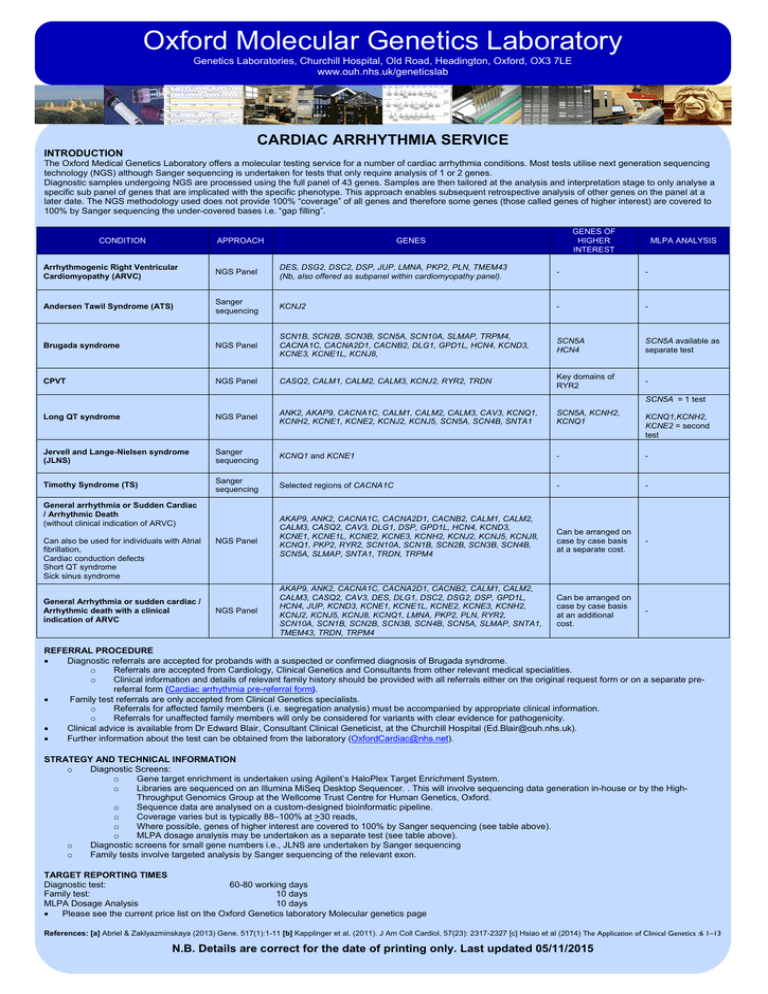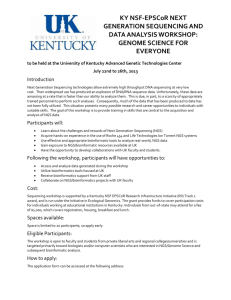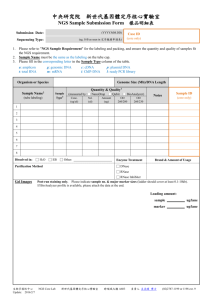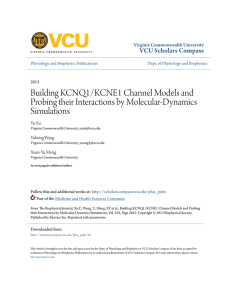CARDIAC ARRHYTHMIA SERVICE INTRODUCTION
advertisement

Oxford Molecular Genetics Laboratory Genetics Laboratories, Churchill Hospital, Old Road, Headington, Oxford, OX3 7LE www.ouh.nhs.uk/geneticslab CARDIAC ARRHYTHMIA SERVICE INTRODUCTION The Oxford Medical Genetics Laboratory offers a molecular testing service for a number of cardiac arrhythmia conditions. Most tests utilise next generation sequencing technology (NGS) although Sanger sequencing is undertaken for tests that only require analysis of 1 or 2 genes. Diagnostic samples undergoing NGS are processed using the full panel of 43 genes. Samples are then tailored at the analysis and interpretation stage to only analyse a specific sub panel of genes that are implicated with the specific phenotype. This approach enables subsequent retrospective analysis of other genes on the panel at a later date. The NGS methodology used does not provide 100% “coverage” of all genes and therefore some genes (those called genes of higher interest) are covered to 100% by Sanger sequencing the under-covered bases i.e. “gap filling”. CONDITION APPROACH GENES OF HIGHER INTEREST GENES MLPA ANALYSIS Arrhythmogenic Right Ventricular Cardiomyopathy (ARVC) NGS Panel DES, DSG2, DSC2, DSP, JUP, LMNA, PKP2, PLN, TMEM43 (Nb, also offered as subpanel within cardiomyopathy panel). - - Andersen Tawil Syndrome (ATS) Sanger sequencing KCNJ2 - - Brugada syndrome NGS Panel SCN1B, SCN2B, SCN3B, SCN5A, SCN10A, SLMAP, TRPM4, CACNA1C, CACNA2D1, CACNB2, DLG1, GPD1L, HCN4, KCND3, KCNE3, KCNE1L, KCNJ8, SCN5A HCN4 SCN5A available as separate test CPVT NGS Panel CASQ2, CALM1, CALM2, CALM3, KCNJ2, RYR2, TRDN Key domains of RYR2 - Long QT syndrome NGS Panel ANK2, AKAP9, CACNA1C, CALM1, CALM2, CALM3, CAV3, KCNQ1, KCNH2, KCNE1, KCNE2, KCNJ2, KCNJ5, SCN5A, SCN4B, SNTA1 SCN5A, KCNH2, KCNQ1 Jervell and Lange-Nielsen syndrome (JLNS) Sanger sequencing KCNQ1 and KCNE1 - - Timothy Syndrome (TS) Sanger sequencing Selected regions of CACNA1C - - Can be arranged on case by case basis at a separate cost. - Can be arranged on case by case basis at an additional cost. - SCN5A = 1 test General arrhythmia or Sudden Cardiac / Arrhythmic Death (without clinical indication of ARVC) Can also be used for individuals with Atrial fibrillation, Cardiac conduction defects Short QT syndrome Sick sinus syndrome General Arrhythmia or sudden cardiac / Arrhythmic death with a clinical indication of ARVC NGS Panel NGS Panel AKAP9, ANK2, CACNA1C, CACNA2D1, CACNB2, CALM1, CALM2, CALM3, CASQ2, CAV3, DLG1, DSP, GPD1L, HCN4, KCND3, KCNE1, KCNE1L, KCNE2, KCNE3, KCNH2, KCNJ2, KCNJ5, KCNJ8, KCNQ1, PKP2, RYR2, SCN10A, SCN1B, SCN2B, SCN3B, SCN4B, SCN5A, SLMAP, SNTA1, TRDN, TRPM4 AKAP9, ANK2, CACNA1C, CACNA2D1, CACNB2, CALM1, CALM2, CALM3, CASQ2, CAV3, DES, DLG1, DSC2, DSG2, DSP, GPD1L, HCN4, JUP, KCND3, KCNE1, KCNE1L, KCNE2, KCNE3, KCNH2, KCNJ2, KCNJ5, KCNJ8, KCNQ1, LMNA, PKP2, PLN, RYR2, SCN10A, SCN1B, SCN2B, SCN3B, SCN4B, SCN5A, SLMAP, SNTA1, TMEM43, TRDN, TRPM4 KCNQ1,KCNH2, KCNE2 = second test REFERRAL PROCEDURE • Diagnostic referrals are accepted for probands with a suspected or confirmed diagnosis of Brugada syndrome. o Referrals are accepted from Cardiology, Clinical Genetics and Consultants from other relevant medical specialities. o Clinical information and details of relevant family history should be provided with all referrals either on the original request form or on a separate prereferral form (Cardiac arrhythmia pre-referral form). • Family test referrals are only accepted from Clinical Genetics specialists. o Referrals for affected family members (i.e. segregation analysis) must be accompanied by appropriate clinical information. o Referrals for unaffected family members will only be considered for variants with clear evidence for pathogenicity. • Clinical advice is available from Dr Edward Blair, Consultant Clinical Geneticist, at the Churchill Hospital (Ed.Blair@ouh.nhs.uk). • Further information about the test can be obtained from the laboratory (OxfordCardiac@nhs.net). STRATEGY AND TECHNICAL INFORMATION o Diagnostic Screens: o Gene target enrichment is undertaken using Agilent’s HaloPlex Target Enrichment System. o Libraries are sequenced on an Illumina MiSeq Desktop Sequencer. . This will involve sequencing data generation in-house or by the HighThroughput Genomics Group at the Wellcome Trust Centre for Human Genetics, Oxford. o Sequence data are analysed on a custom-designed bioinformatic pipeline. o Coverage varies but is typically 88–100% at >30 reads, o Where possible, genes of higher interest are covered to 100% by Sanger sequencing (see table above). o MLPA dosage analysis may be undertaken as a separate test (see table above). o Diagnostic screens for small gene numbers i.e., JLNS are undertaken by Sanger sequencing o Family tests involve targeted analysis by Sanger sequencing of the relevant exon. TARGET REPORTING TIMES Diagnostic test: 60-80 working days Family test: 10 days MLPA Dosage Analysis 10 days • Please see the current price list on the Oxford Genetics laboratory Molecular genetics page References: [a] Abriel & Zaklyazminskaya (2013) Gene. 517(1):1-11 [b] Kapplinger et al. (2011). J Am Coll Cardiol, 57(23): 2317-2327 [c] Hsiao et al (2014) The Application of Clinical Genetics :6 1–13 N.B. Details are correct for the date of printing only. Last updated 05/11/2015






